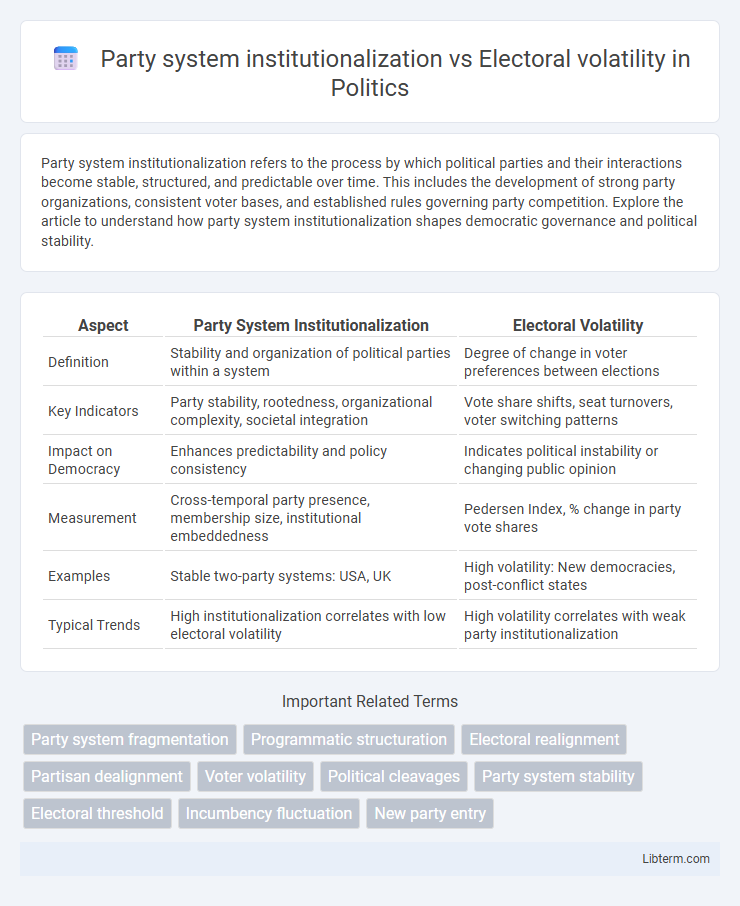Party system institutionalization refers to the process by which political parties and their interactions become stable, structured, and predictable over time. This includes the development of strong party organizations, consistent voter bases, and established rules governing party competition. Explore the article to understand how party system institutionalization shapes democratic governance and political stability.
Table of Comparison
| Aspect | Party System Institutionalization | Electoral Volatility |
|---|---|---|
| Definition | Stability and organization of political parties within a system | Degree of change in voter preferences between elections |
| Key Indicators | Party stability, rootedness, organizational complexity, societal integration | Vote share shifts, seat turnovers, voter switching patterns |
| Impact on Democracy | Enhances predictability and policy consistency | Indicates political instability or changing public opinion |
| Measurement | Cross-temporal party presence, membership size, institutional embeddedness | Pedersen Index, % change in party vote shares |
| Examples | Stable two-party systems: USA, UK | High volatility: New democracies, post-conflict states |
| Typical Trends | High institutionalization correlates with low electoral volatility | High volatility correlates with weak party institutionalization |
Defining Party System Institutionalization
Party system institutionalization refers to the stability and predictability of political parties' behavior, characterized by consistent inter-party competition, strong party organizations, and voter loyalty over time. It involves regular patterns of political interaction and the embedding of parties within the political and social framework, limiting sudden changes in party alignments. Electoral volatility measures the degree of change in voter preferences between elections, typically decreasing as party system institutionalization strengthens.
Understanding Electoral Volatility
Electoral volatility measures the degree of change in voter preferences between elections, reflecting instability in the party system. High electoral volatility indicates weak party system institutionalization, where parties lack consistent voter bases and organizational stability. Understanding electoral volatility is crucial for analyzing democratic consolidation and predicting political stability.
Historical Context of Party Systems
Historical context significantly shapes the institutionalization of party systems, influencing their stability and organizational coherence over time. In mature democracies, long-established party systems tend to exhibit low electoral volatility due to entrenched party identities and consistent voter alignments. Conversely, emerging democracies or periods of political transition often experience high electoral volatility, reflecting weak institutionalization and fluctuating voter preferences amid evolving political landscapes.
Indicators of Party System Institutionalization
Indicators of party system institutionalization include party stability, organizational strength, and rootedness in society, which collectively reduce electoral volatility by fostering consistent voter-party alignment. Stable party systems exhibit strong party organizations, predictable electoral outcomes, and durable voter loyalties, minimizing vote swings between elections. High institutionalization correlates with well-established party identities and clear linkages to social groups, thereby decreasing electoral volatility and enhancing democratic consolidation.
Drivers of Electoral Volatility
Electoral volatility is driven by factors such as party system institutionalization, where weakly institutionalized systems exhibit higher voter shifts between elections due to fluid party loyalties and unstable political alignments. Socioeconomic changes, political scandals, and issue realignment also contribute to volatility by altering voter preferences and reducing party identification. Moreover, a fragmented party system and the emergence of new parties intensify electoral volatility through increased competition and voter reevaluation.
Impact of Volatility on Party System Stability
High electoral volatility often undermines party system institutionalization by disrupting voter-party linkages and weakening party organizational roots. This instability fosters fragmented political landscapes, reducing consistent policy agendas and hindering democratic consolidation. Sustained volatility correlates with lower party system stability, impeding effective governance and eroding public trust in political institutions.
Relationship Between Institutionalization and Volatility
Strong party system institutionalization correlates with low electoral volatility due to stable party structures and consistent voter alignments. High levels of institutionalization promote party discipline, clear ideological platforms, and durable party organizations, which reduce voter switching between elections. Conversely, weak institutionalization results in fragmented parties and fluctuating voter preferences, increasing volatility levels in the electoral process.
Case Studies: Comparative Analysis Across Countries
Party system institutionalization often correlates inversely with electoral volatility, as seen in established democracies like Germany and Japan, where stable party structures reduce voter shifts. Contrarily, countries with lower institutionalization, such as Italy and Brazil, exhibit higher electoral volatility due to weak party identification and frequent party realignments. Comparative analysis highlights that institutional factors like party roots, organization, and societal embedding critically influence electoral stability across diverse political contexts.
Consequences for Democratic Consolidation
High party system institutionalization, characterized by stable party roots, consistent voter alignment, and durable organizational structures, reduces electoral volatility and promotes democratic consolidation by fostering accountability and political predictability. Conversely, elevated electoral volatility, often signaling fragmented or weak party systems, can undermine policy continuity, erode public trust, and destabilize democratic regimes. Strong institutionalization enables sustained party competition and effective governance, forming a critical foundation for stable, resilient democracies.
Policy Implications and Future Prospects
High party system institutionalization often correlates with reduced electoral volatility, providing policy stability and coherent long-term governance strategies. Low institutionalization can lead to fragmented policymaking, frequent shifts in political priorities, and challenges in sustaining consistent reform agendas. Future prospects suggest that enhancing institutional frameworks and party cohesion is essential for improving policy predictability and democratic consolidation.
Party system institutionalization Infographic

 libterm.com
libterm.com